#Indigenous art
Text
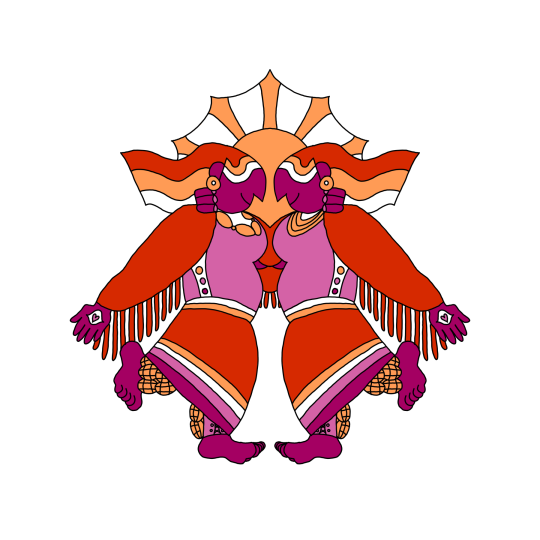
just catching the end of lesbian visibility week but !!! ndn lesbian love <3
REALLY in love w this design, i had it sitting in wip for ages bc i wanted to get it done just right. tip me or cop this on my bonfire and inprnt !
200 notes
·
View notes
Text
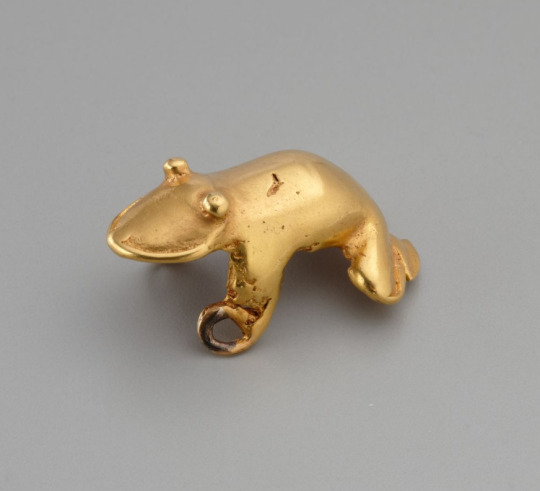
Frog pendant, Diquis culture, Costa Rica, circa 1200 AD
from The Yale University Art Museum
128 notes
·
View notes
Text

Stikine division of Tlingit
Bear Screen
Northwest Coast: Tlingit
Native American, North American Indian, Tlingit
Circa 1840
This screen is perhaps the most important crest of the Shakes clan. The figure of a squatting bear with a doorway through her vagina is frontally presented, with arms crooked at the elbow so that her hands face palms forward just below her cheeks. The elbows nearly touch her bent knees. The ears (with tendants of hair on the outer edges), head, arms, hands, and legs are all red and without outlines, as are the organs of the body, which are depicted in X-ray style. The features of the face, the outline of the body, and the feet are all in black. Small, squatting figures of bears occupy each of the ears as filler designs. The face is carved slightly in bas-relief, the technique being highlighted by the black eyebrow, black-outlined eyes, black nose, and widespread mouth with black lips. The teeth, though carved, are unpainted. Small anthropomorphic faces fill in the pupils and nostrils. More conventionalized black faces with features in natural wood occupy negative space in the palms, elbows, and knees. Similar conventionalized faces are seen at the top, each side, and in the middle of the trunk of the bear-wife's body. These serve as a frame for her internal organs.
84 notes
·
View notes
Text




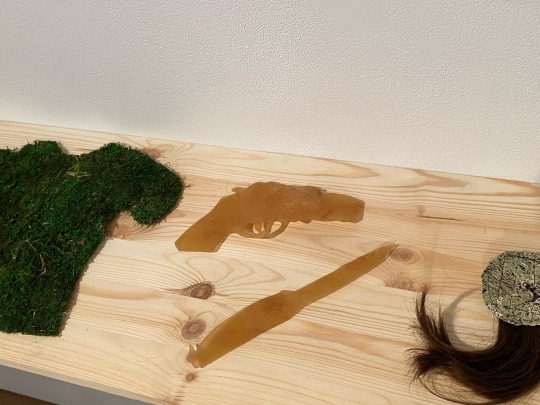
ᓄᐦᑕᐃᐧᕀ ᐊᐢᑯᑖᐢᑯᐱᓱᐣ nohtawiy askotâskopison, My Father’s Cradleboard by Morgan Possberg Denne
The New Gallery, November 18 - December 22, 2023
“Cradleboards have been used for thousands of years by our ancestors to carry and love for our future generations. They have protected us, acted as an external womb, and given us a place as children to watch our parents' culture and learn from a safe distance. I’ve always wondered if the fact that neither my father, his father, or myself was ever put in a cradleboard may have had a long term impact on our development, personhood, and our coping mechanisms to the ways that colonialism, residential schools and the foster care system has affected my family.
Now as an adult I deeply wish I could rewind the clock and put myself, and my father before me, and his father before him in a cradleboard as a child. To softly sing songs to us, give us safety, and to give us a connection to our culture in a safe environment. Maybe this would fix things. As kids when we were supposed to be kept safe and playing in the woods we were instead being prepped for the meat factory - the eternal meat grinder of colonialism.
The western world teaches us to push aside this childhood imagining and innocence - “These things can’t be undone!”, but what if they could? In another world somebody took better care of us, in another time we learned to drum and sing and dance, in another place we were listened to by adults who had the capacity to love and care for us.
These hot chest and aching throat feelings, the times of biting back angry tears and saying “It’s fine” have to count for something….right?”
“Morgan Possberg Denne is Two-Spirit millennial scoop and foster care survivor; with settler, Cree, Metis, and Chippewa blood connections. They have grown up in treaty 7 territory, and have relatives in southern and northern Ontario. Morgan creates imaginative, illustrative objects which could be seen as pieces of possible narratives, different ways to connect with the past and potential futures through layers of abstraction with no right or wrong answer. What matters to them is not accurately recreating the past or to predict the future, but rather to capture an inner truth and a possible alternative reality of colonial experiences. In a sense, creating new culture from a series of “what-ifs” and new stories / lore. Their work has been recently shown at the Confederation Centre for the Arts and Gallery Gachet.”
(Photos belong to me and the description and artist bio are courtesy of The New Gallery’s website)
[IDs:
1. a large wall hanging made from fish leather,
2. a close up of the same piece. the artwork has faint text cut out of the green tea tanned fish that reads “hey it’s not your fault, you know that right?”
3. a photo of the space showing a video projected onto several fish skins, a table with a vest and a hat made of fish leather, and on the table are cartons made from rawhide.
4. a coatrack on which are a rawhide hunting ruffle and rawhide fishing net resembling a badminton racket
5. a shelf seen in the background of image 3 containing a astro-turf shirt, a hand gun and pocket knife made from rawhide and a fish leather circular clip with a piece of dark hair hanging off the shelf.]
#my picks#morgan is a dear friend of mine <3#they taught me how to tan fish leather!#art#indigenous art#cree#métis#chippewa#canadian art#contemporary art#indigenous contemporary art#curation#artist run centre#artists#fish leather#leather#rawhide#traditional art#sculpture#installation#video art#my images
43 notes
·
View notes
Video
Indigenous Horror Films
#tiktok#indigenous horror films#Indigenous art#Indigenous writers#Indigenous artists#indigenous#watch this#mexican indigenous folklore#folklore#horror#horror films#movies#film#inuit#indie horror film#mythology
13K notes
·
View notes
Text




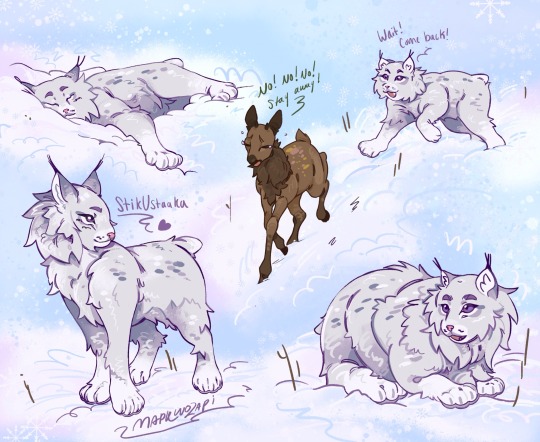





Mlp native au animal au plains au? I love them. I never got around to cadence but she was gonna carry Wohpe. If you never seen my old TikTok’s basically twilight was sent to earth from the sky world to escape nightmare moon.
#my art#originalart#character design#native artist#mlp#mlp au#mlp fim#mlp fim redesign#mlp fim au#my little pony friendship is magic#my little pony#indigenous art
2K notes
·
View notes
Text
reminder that women helping women beadwork (a non-profit ig page selling beadwork made by incarcerated indigenous women) is putting out new pride pieces pretty much everyday so if you'd like some beautiful rainbow jewelry that directly supports these women please check them out ❤️🧡💛💚💙💜🩷🤍🩵🤎🖤


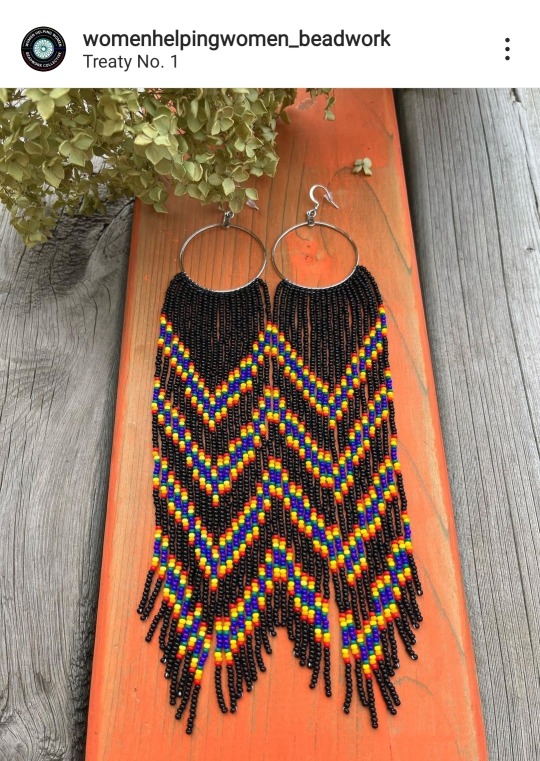


8K notes
·
View notes
Text

Article Link
"Minnetonka first started selling its “Thunderbird” moccasins in 1965. Now, for the first time, they’ve been redesigned by a Native American designer.
It’s one step in the company’s larger work to deal with its history of cultural appropriation. The Minneapolis-based company launched in the 1940s as a small business making souvenirs for roadside gift shops in the region—including Native American-inspired moccasins, though the business wasn’t started or run by Native Americans. The moccasins soon became its biggest seller.

[Photo: Minnetonka]
Adrienne Benjamin, an Anishanaabe artist and community activist who became the company’s “reconciliation advisor,” was initially reluctant when a tribal elder approached her about meeting with the company. Other activists had dismissed the idea that the company would do the work to truly transform. But Benjamin agreed to the meeting, and the conversation convinced her to move forward.
“I sensed a genuine commitment to positive change,” she says. “They had really done their homework as far as understanding and acknowledging the wrong and the appropriation. I think they knew for a long time that things needed to get better, and they just weren’t sure what a first step was.”

Pictured: Lucie Skjefte and son Animikii [Photo: Minnetonka]
In 2020, Minnetonka publicly apologized “for having benefited from selling Native-inspired designs without directly honoring Native culture or communities.” It also said that it was actively recruiting Native Americans to work at the company, reexamining its branding, looking for Native-owned businesses to partner with, continuing to support Native American nonprofits, and that it planned to collaborate with Native American artists and designers.
Benjamin partnered with the company on the first collaboration, a collection of hand-beaded hats, and then recruited the Minneapolis-based designer Lucie Skjefte, a citizen of the Red Lake Nation, who designed the beadwork for another moccasin style and a pair of slippers for the brand. Skjefte says that she felt comfortable working with the company knowing that it had already done work with Benjamin on reconciliation. And she wasn’t a stranger to the brand. “Our grandmothers and our mothers would always look for moccasins in a clutch kind of situation where they didn’t have a pair ready and available to make on their own—then they would buy Minnetonka mocs and walk into a traditional pow wow and wear them,” she says. Her mother, she says, who passed away in 2019, would have been “immensely proud” that Skjefte’s design work was part of the moccasins—and on the new version of the Thunderbird moccasin, one of the company’s top-selling styles.
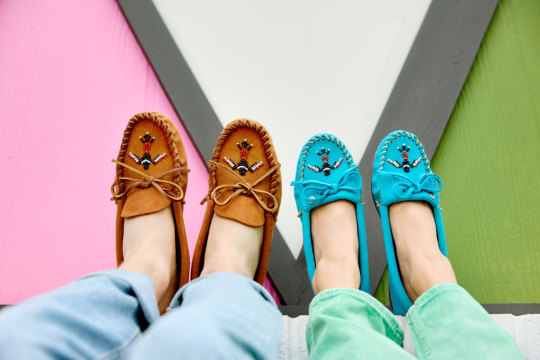
[Photo: Minnetonka]
“I started thinking about all of those stories, and what resonated with me visually,” Skjefte says. The redesign, she says, is much more detailed and authentic than the previous version. “Through the redesign and beading process, we are actively reclaiming and reconnecting our Animikii or Thunderbird motif with its Indigenous roots,” she says. Skjefte will earn royalties for the design, and Minnetonka will also separately donate a portion of the sale of each shoe to Mni Sota Fund, a nonprofit that helps Native Americans in Minnesota get training and capital for home ownership and entrepreneurship.
Some companies go a step farther—Manitobah Mukluks, based in Canada, has an Indigenous founder and more than half Indigenous staff. (While Minnetonka is actively recruiting more Native American workers, the company says that employees self-report race and it can’t share any data about its current number of Indigenous employees.) Beyond its own line of products, Manitobah also has an online Indigenous Market that features artists who earn 100% of the profit for their work.
White Bear Moccasins, a Native-owned-and-made brand in Montana, makes moccasins from bison hide. Each custom pair can take six to eight hours to make; the shoes cost hundreds of dollars, though they can also be repaired and last as long as a lifetime, says owner Shauna White Bear. In interviews, White Bear has said that she wants “to take our craft back,” from companies like Minnetonka. But she also told Fast Company that she doesn’t think that Minnetonka, as a family-owned business, should have to lose its livelihood now and stop making moccasins.
The situation is arguably different for other fashion brands that might use a Native American symbol—or rip off a Native American design completely—on a single product that could easily be taken off the market. Benjamin says that she has also worked with other companies that have discontinued products.
She sees five steps in the process of reconciliation. First, the person or company who did wrong has to acknowledge the wrong. Then they need to publicly apologize, begin to change behavior, start to rebuild trust, and then, eventually, the wronged party might take the step of forgiveness. Right now, she says, Minnetonka is in the third phase of behavior change. The brand plans to continue to collaborate with Native American designers.
The company can be an example to others on how to listen and build true relationships, Benjamin says. “I think that’s the only way that these relationships are going to get any better—people have to sit down and talk about it,” she says. “People have to be real. People have to apologize. They have to want to reconcile with people.”
The leadership at Minnetonka can also be allies in pushing other companies to do better. “My voice is important at the table as an Indigenous woman,” Benjamin says. “Lucie’s voice is important. But at tables where there’s a majority of people that aren’t Indigenous, sometimes those allies’ voices are more powerful in those spaces, because that means that they’ve signed on to what we’re saying. The power has signed on to moving forward and we agree with ‘Yes, this was wrong.’ That’s the stuff that’s going to change [things] right there.”"
-via FastCompany, February 7, 2024
#indigenous#indigenous artists#indigenous art#moccasins#thunderbird#native american#native american art#cultural appropriation#indigenous peoples#cultural representation#minnesota#minnetonka#minneapolis#red lake nation#ojibwe#anishinaabe#reconciliation#fashion#fashion news#good news#hope#indigenous designers#native artist#indigenous artist
1K notes
·
View notes
Text
Keep talking about Gaza.
Keep talking about Palestine.
Keep talking about Palestinian martyrs.
Keep talking about Palestinian survivors.
Keep talking about Palestinian children.
Keep talking about war crimes.
Keep talking about genocide.
Keep talking about colonialism.
Keep talking about forced starvation.
Keep talking about forced adoption.
Keep talking about Israeli occupation.
Keep talking about the Nakba of 1948.
KEEP TALKING ABOUT WHAT IS HAPPENING TO PALESTINE
Keep boosting Palestinian history.
Keep boosting Palestinian graphics.
Keep boosting Palestinian poetry.
Keep boosting Palestinian fashion.
Keep boosting Palestinian textiles.
Keep boosting Palestinian art.
Keep boosting Palestinian culture.
Keep boosting Palestinian values.
Keep boosting Palestinian stories.
Keep boosting Palestinian voices.
Keep boosting Palestinian life.
Keep boosting Palestinian loss.
Keep boosting Palestinian love.
Keep boosting Palestinian grief.
Keep boosting Palestinian hope.
KEEP BOOSTING PALESTINIAN HUMANITY
#free palestine#anti genocide#jews for palestine#free gaza#gaza genocide#palestine will be free#boycott divest sanction#end israeli occupation#jewish antizionism#anti zionisim#anti colonialism#anti colonization#palestinian art#palestinian history#palestine art#palestine news#gaza art#indigenous art#indigenous rights#indigenous culture#palestinian children#free palestine art#palestinian artist#palestinian fashion#palestinian poetry#palestinian writers
965 notes
·
View notes
Text

FORMLINE RAPTOOOOOOOOR!!!!!
this design is a birthday gift for my brother!! It's based off one of his fave basketball teams (yes the toronto raptors, no I don't know a damn thing about competitive basketball)
#this design is probably not accurate according to paleontologist standards/research and we are going to make our peace with that#ok? ok.#man i sure hope I don't get sued by the nba :)#paleo art#formline art#indigenous art#telekitnetic art
3K notes
·
View notes
Text
so I found this really cool website that sells native seeds- and you might be asking me "snekdood, haven't you posted an entire list of websites that sell native wildflower seeds that you're going to add on to soon?" and yes that's true, but that's not the kind of native seed im talking about rn.
see, on my quest to find websites that sell native wildflowers, I came across this dope ass website that sells seeds that have been farmed and harvested by ntv people traditionally, i'll let the website do the talking:




so anyways this is the coolest website ever. you can find the wild relatives of chiles on here called chiltepines, you can find different colors of corn and cool squash's, and every seed from whichever farm has it's own lil origin story written about it. you can also find other veggies here that are already commercially available to help fund and support this organization. as well as there being a cool gift shop with a lot of art made by different native folk from all around as well as cookbooks, jewelry, pottery, weavings, and clearly plenty more:

as well as a pantry?? with premade soup mixes??? and i really want to try them now??????
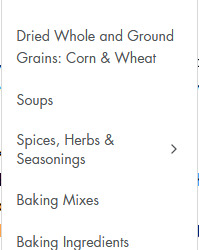
anyways I think its worth snoopin' around bc I'm almost positive you'll see something you think is cool (oh also if you happen to have some seeds passed down from ur family too and ur also native they seem like they would gladly help produce more)
#heirloom seeds#native plants#native wildflowers#native seeds#native seeds search#gardening#farming#seed conservation#heirloom vegetables#vegetables#crops#food#native american#native american traditions#native american heirloom seeds#support indigenous people#indigenous art
2K notes
·
View notes
Text

Jade bead necklace, Olmec, 1200-900 BC
from The Walters Art Museum
#history#antiquities#art#ancient history#ancient art#jewelry#jewellery#olmec#indigenous art#precolumbian art#precolumbian
652 notes
·
View notes
Text
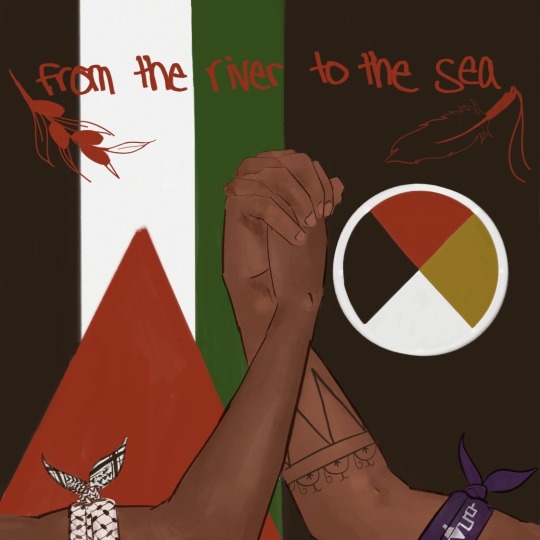
🕊️freedom from settler colonialism now and forever🪶🇵🇸
#my art#native american heritage month#indigenous art#if anyone has any advice on how to do alt text for drawings / what i should use for this please let me know
2K notes
·
View notes
Text

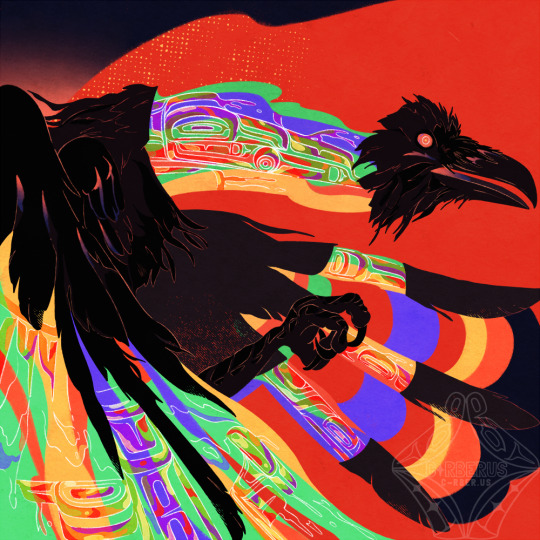
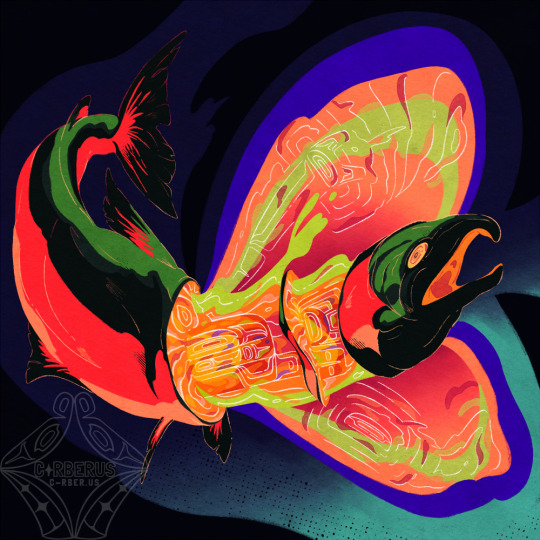
ts'msyenu a ts'm g̱a̱w'iłeeyu - tsimshian in my veins.
series of illustrations completed over last month 🐟
the illustration with the raven i first did a couple years ago; i completely re-drew it, and expanded on the concept by creating the other two works. i was guided by a hope to combine the ideas of Indigenous kinship with other-than-humans, and a critique of blood quantum.
prints: wolf, raven, salmon | wolf illustration timelapse (patreon)
3K notes
·
View notes
Text
Here's something new to know about me. I'm a Murramarang woman from the south coast of New South Wales, and an Aboriginal Artist. I'm learning and trying to bring Dhurga (my native language) back to life after it was nearly destroyed during colonisation.
Here are a couple of my paintings.
The first is a Giriwa (goanna), the totem of my tribe, painted in our traditional x-ray style. This type of painting was used to illustrate and educate, to teach biology and anatomy.
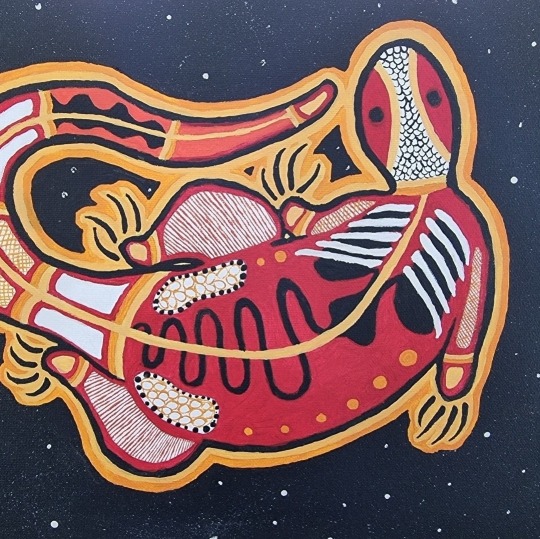
The second is a warigal (dingo) painted in a more decorative style, with a fusion of our more narrative style of art and my own modern style.

If you've stumbled upon this post, I hope you learned something from it! I love sharing my culture ❤💛🖤
6K notes
·
View notes
Text



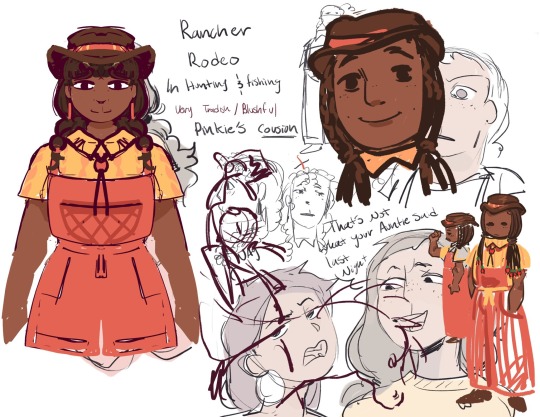


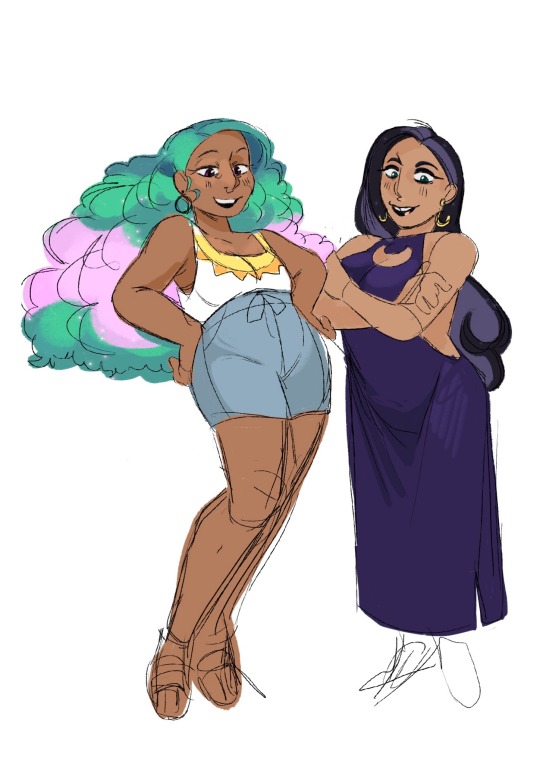
I realize I never posted the concept art I did for my mlp redesigns, and I can’t believe it’s actually been three years since I started them, apple Jack definitely had the most drafts. Every time I see Luna’s design I miss my aunties so much 😭 the only people I know that can rock black lipstick 💄
#my art#originalart#character design#native artist#mlp#mlp fim redesign#mlp fim au#mlp fan art#mlp art#my little pony#my little pony friendship is magic#indigenous art
1K notes
·
View notes